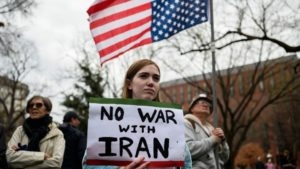It’s a measure of this dangerous moment that many observers felt relief on Tuesday night after the Pentagon announced that there had been no American casualties following Iran’s launch of 22 ballistic missiles at bases housing U.S. troops in Iraq. “It’s been a very long time since U.S. forces have been directly struck by ballistic missiles,” Ilan Goldenberg, a former Defense Department official who focused on Iran in the Obama administration, told me, describing the attack as “historic.”
But in the wake of last week’s killing of Iran’s top general, Qassem Soleimani, Goldenberg and other veteran Iran watchers told me, the limited damage from Iran’s response may actually present a chance for both sides to step back from the brink. Iran is clearly capable of much worse, in Iraq and elsewhere. The proxy and terrorist networks that Soleimani spent a lifetime building remain strong after his death. The missiles caused no American or Iraqi deaths as of Wednesday morning. Iraq’s prime minister said that Iran even provided advance warning. Though Iran’s response was uncharacteristic in that it claimed responsibility for the attack—usually it prefers to have some deniability—the country’s foreign minister, Javad Zarif, seemed to offer a message of de-escalation, tweeting that Iran “took and concluded proportionate measures in self-defense.” He added: “We do not seek escalation or war.”
In an address today, President Donald Trump walked back his recent escalatory rhetoric, expressing relief that no U.S. lives had been lost. Evan as he condemned Iran, vowed that it would never have a nuclear weapon, and pledged to impose new sanctions, he offered a starkly different tone from his threats earlier this week to bomb Iranian cultural sites. “To the people and leaders of Iran, we want you to have a future, and a great future, one that you deserve—one of prosperity at home and harmony with the nations of the world,” he said. “The United States is ready to embrace peace with all who seek it.”
The U.S. government was likely expecting the strikes, Douglas London, a professor at Georgetown who recently retired from a 34-year career in the CIA’s clandestine service, told me. The U.S. intelligence community has long assessed, he said, how Iran would respond to an attack like the one that killed Soleimani. This assessment “has been consistent and well briefed” to American presidents, he added. “There were no surprises here. Iran appears to have telegraphed and pulled its punches somewhat.”
London, who focused on Iran during his CIA career, noted the difference between a successful drone and missile attack against a Saudi oil facility in September, which U.S. officials have attributed to Iran, and the attack on Tuesday, in which all 22 of the missiles Iran fired managed to miss Americans. “The Iranians don’t have accidents like that,” London told me. So there may be an opportunity “for both sides to walk away.”
But will Trump take it?
“We killed Soleimani to establish deterrence and impose some sort of escalation dominance on Iran—that we are willing to go farther in this cycle than they are—because it had obviously crossed a number of red lines in recent months. Clearly Iran has to respond,” Faysal Itani, a deputy director at the Center for Global Policy, told me. For months, Iran-backed militias in Iraq had been launching rockets toward U.S. troops, until an attack on December 27 killed an American contractor. After Trump responded with strikes that killed militiamen, and Iran-backed protesters attempted to storm the U.S. embassy in Baghdad, Trump ordered the strike on Soleimani. Itani said that if Tuesday’s missile attacks are the extent of Iran’s retaliation for its commander’s death, there’s no need for America to respond. “The U.S. hit them harder than they hit it, and deterrence is in place,” he said. “My fear is that Trump may not see it that way, and may choose to escalate yet again.”
Trump and his advisers say that the goal of their so-called maximum-pressure campaign is to bring Iran back to the negotiating table, yet it often feels more like a push to topple the regime. In any case, it has not stopped any of the Iranian activities U.S. officials so often criticize—threats of further nuclear enrichment, support for proxies, expanding influence around the Middle East.
Even so, this precarious moment offers Trump the chance to pull a tenuous win from the flotsam of his Iran strategy. “Iran appears to be standing down, which is a good thing for all parties concerned and a very good thing for the world,” Trump said in today’s address. As Michael Pregent, a senior fellow at the Hudson Institute who worked as a U.S. intelligence officer in Iraq, told me, Trump’s decision to kill Soleimani “was such a blow to the regime that it may actually be the de-escalation event we were looking for. If this is it, then we got Soleimani, and they know this American president is serious.”
That assumes that this is the most tense moment—and that Trump will continue to take the high road not just today but every day as the standoff simmers. One likely outcome, London and others told me, is that Iran, having launched this rare public strike, now returns to the kind of shadow and proxy warfare for which it is notorious. While he stopped short of vowing another military strike, Ayatollah Ali Khamenei, Iran’s supreme leader, threatened further retaliation, saying that true retribution for Soleimani’s death would come against U.S. troops leaving the Middle East. If the Iraqi Parliament’s recent vote is enforced, U.S. troops will be out of Iraq before too long.
Colin Clarke, a research fellow at the Soufan Center, told me that the next phase of Iranian retribution could focus on “a prolonged campaign of proxy attacks by the range of Iranian proxy forces, including Lebanese Hezbollah, Iraqi Shia militias, and the Houthi rebels in Yemen. Both sides likely want to de-escalate tensions, but that merely brings things back to the status-quo ante, which is where things stood in the summer of 2019.”
In other words, the U.S. and Iran may be right back where they were before the Soleimani strike—caught in a precarious standoff in which they may be one American death away from the new war Trump says he doesn’t want.
We want to hear what you think about this article. Submit a letter to the editor or write to [email protected].






